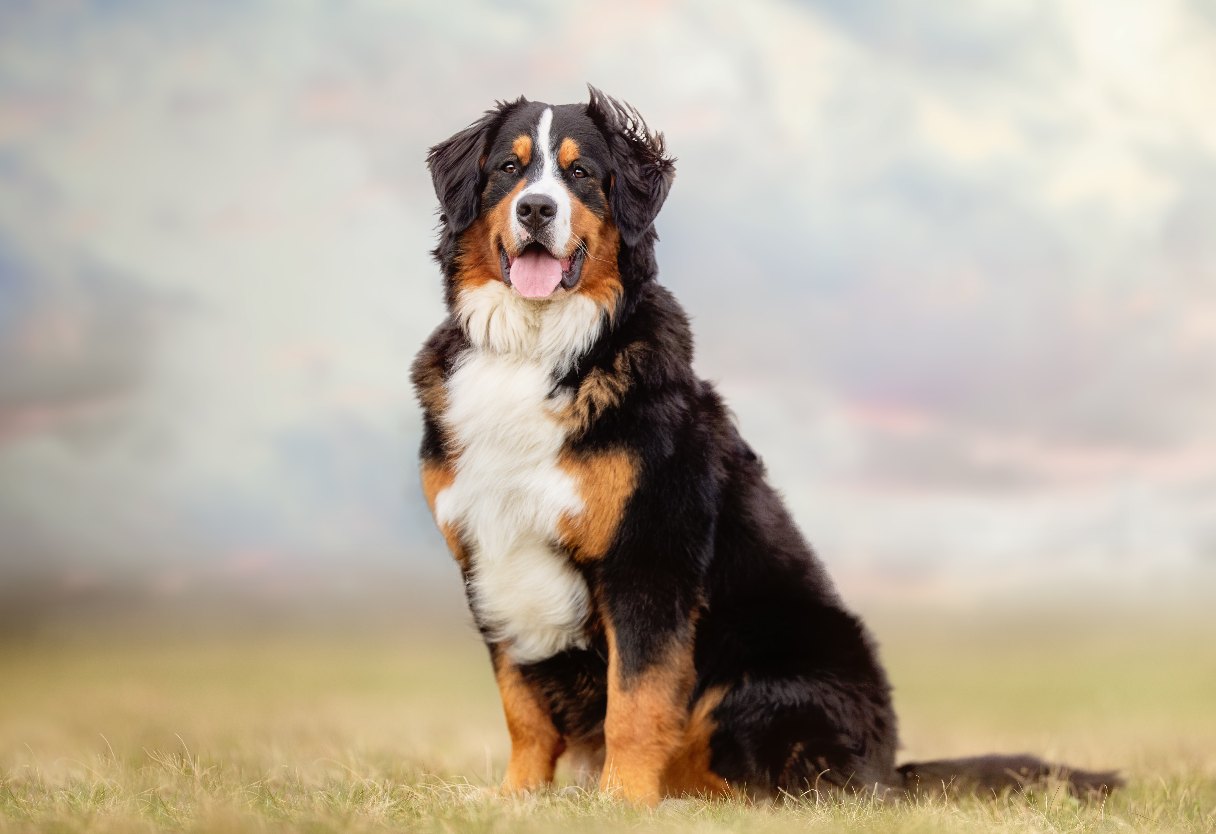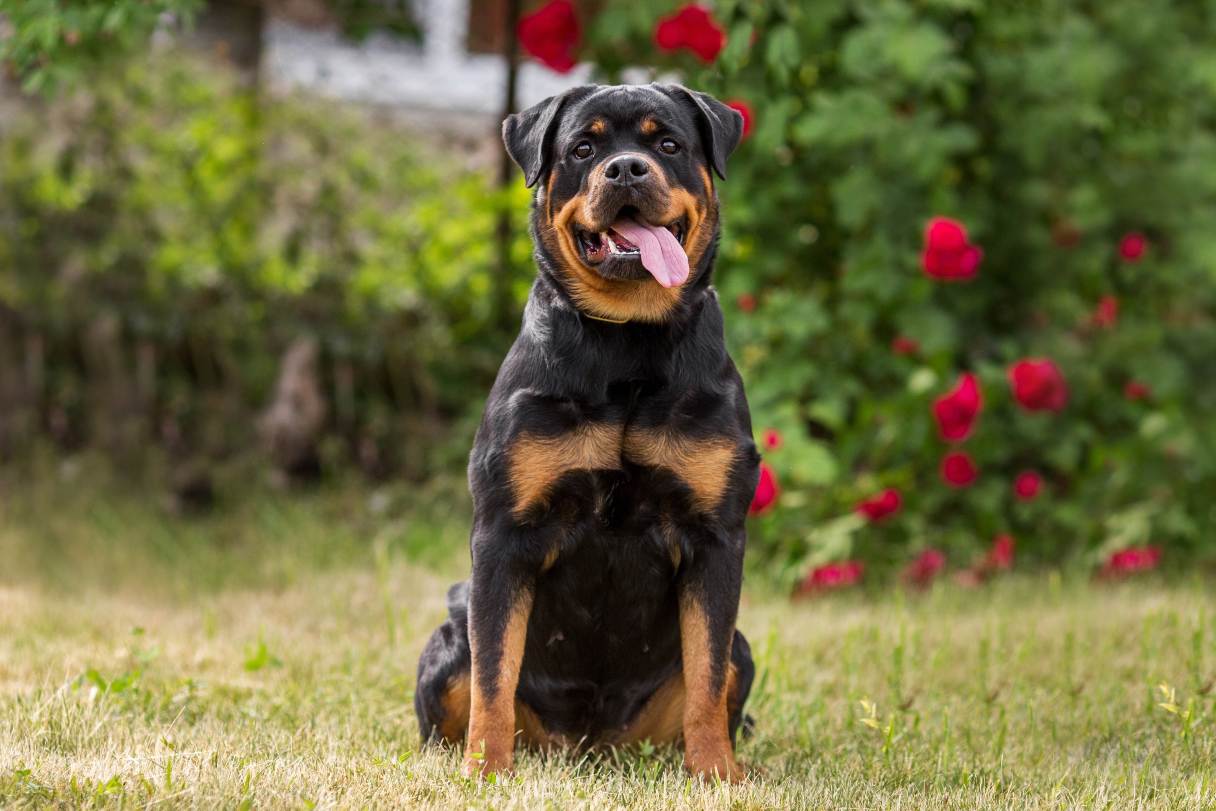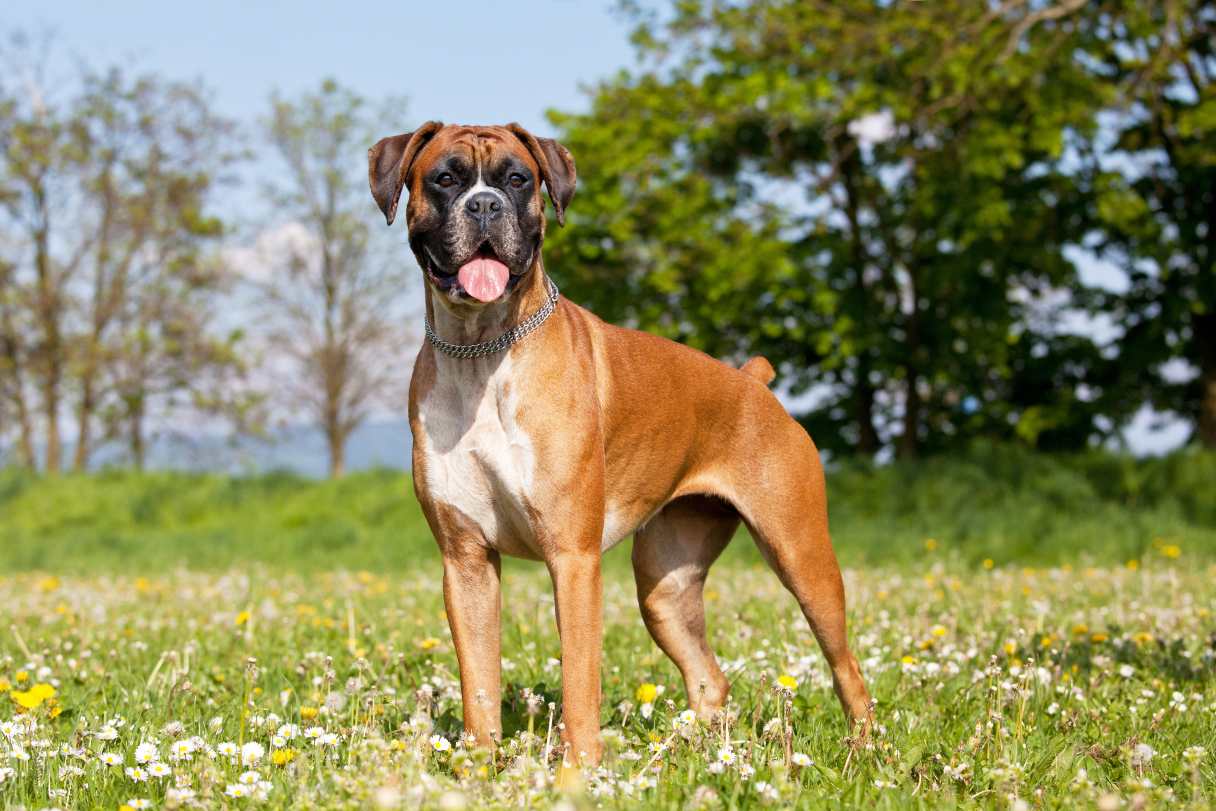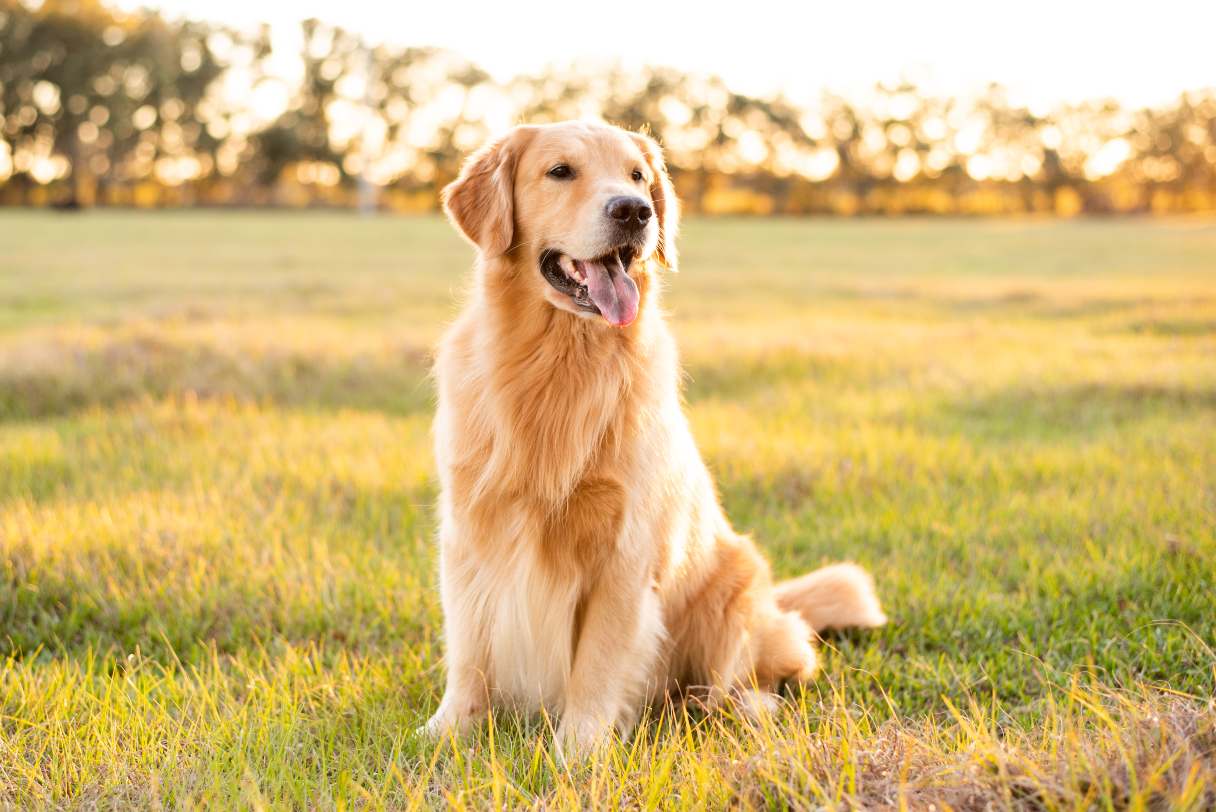Big, beautiful and absolutely darling, the Bernese mountain dog was bred for companionship as much as they were to be hardworking, all-around farm dogs. Today’s Berners, as they are affectionately known, make excellent family pets, but their tendency to fall in love with a special person also makes them great dogs for single folks who can provide them with the company they crave.1
Keep reading to learn more about the Bernese mountain dog and what it’s like to live with and care for these big, sweet babies.
About the Bernese Mountain Dog
Berners are one of four similar large dog breeds from the Bern region of Switzerland, an agricultural area renowned for its cheese and chocolate. These dogs are thought to have descended from a cross between native black-and-tan mountain dogs and Molossers, the ancestors of the modern mastiff breeds that were brought through the Swiss mountains by Roman soldiers in ancient times.2
The only long-haired member of this breed group, Berners held many occupations around the farm, including driving and guarding cattle, pulling heavy carts and providing farmers with companionship at the end of a long day. The introduction of modern farming equipment in the late 1800s reduced their usefulness as farm dogs, and the breed began to dwindle. Around the turn of the 20th century, breed enthusiasts began working to restore them, forming a Swiss breed club in 1907 that succeeded in reviving the Berner’s popularity as both a farm helper and a companion dog.1
Bernese mountain dogs were first brought to the United States in 1926 by a Kansas farmer named Isaac Schliess; a decade later another pair was imported by a Louisiana man named Glen Shadow.2 Both men succeeded in raising the breed's profile in the states.2 The Bernese mountain dog was officially recognized by the American Kennel Club in 1937 and has since remained one of the AKC’s most popular breeds.3
Bernese Mountain Dog Appearance
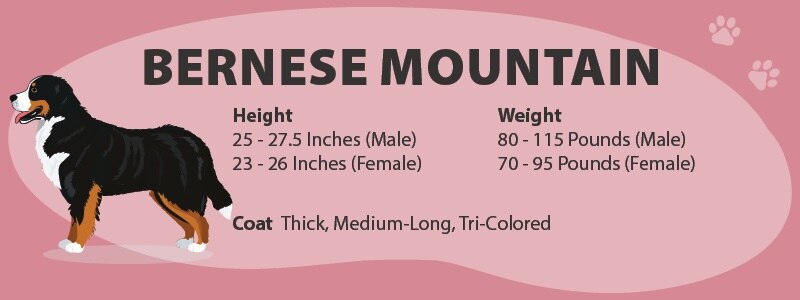
The Berner is described as large and sturdy, standing 25 to 27.5 inches at the shoulder and weighing 80 to 115 pounds. Females are slightly smaller, standing 23 to 26 inches and weighing 70 to 95 pounds.1
The body is slightly longer than it is tall, with a broad back and a long, bushy tail. Though strong-boned and strong-muscled, Berners are agile enough to pull carts, chase cattle and compete in agility sports.4
The Berner’s head is broad, with a straight muzzle ending in a black nose. The dark brown eyes are almond-shaped, intelligent, expressive and gentle. The triangular ears are rounded at the tip and hang down in relaxed mode, but perk up at the base when alert.4
Apart from its size, the Berner’s coat is its most recognizable feature. Thick and medium-long, the hair may be straight or slightly wavy. The distinctive tricolored coat is mostly black with markings of white and either rust or tan.4
Bernese Mountain Dog Temperament
The official breed standard describes Berners as “self-confident, alert and good-natured.”4 A properly socialized Berner is laid-back and gentle and extremely affectionate with their loved ones. They’re generally nonaggressive but can be protective when they deem it necessary.5
While the breed standard states that well-socialized Berners should be aloof but confident with strangers, the Bernese Mountain Dog Club of America warns that many Berners tend to be shy around unfamiliar people. However, exposing Berner puppies to as many people, places and situations as possible early in life can help reduce their shyness.5
Berners are intelligent dogs who want to make their owners happy, and training with positive training methods tends to be a breeze. But they are also gentle souls who easily get their feelings hurt and don’t learn well with cross words or harsh training methods. Early obedience training is a must to teach these large pups good manners and self-control.6
Also, while they learn the concept of potty training easily enough, Bernese mountain dog puppies don’t have full bladder control until they’re 6 months old. Until then, frequent trips outside are needed to prevent accidents.6
Living With a Bernese Mountain Dog
As darling as these gentle companions are, they may not be the best dog for everyone. Here’s a glimpse of what life is like with a Bernese mountain dog.
Who they’re best for
Berners get the AKC’s highest ratings in the categories “Affectionate With Family,” “Good With Young Children” and “Good With Other Dogs.” They make a wonderful family dog for those who can handle their size and care requirements. That said, they also tend to bond with a favorite person and can happily be a single person’s best furry friend.1
Berners need a lot of companionship, making them a poor fit for families that are frequently away. They need to be around people, and they can develop behavior problems if left alone for extended periods. Ideally, they should live in a household where someone is available throughout the day to give them lots of love and attention.5
Living space
Berners were bred for farms, but they’re a versatile breed that can thrive in the suburbs or the countryside as long as they have a large yard with a sturdy fence. Without ample space to roam, your Berner will need daily walks to keep them fit and healthy.5
Nevertheless, despite their size, they’re meant not to be kept outdoors but to live indoors with their people. They are built for colder climates and tend to do best in cold weather. During hot seasons, they should be kept inside to enjoy the air conditioning as much as possible, limiting outdoor exercise and activity to the cooler hours of the morning and evening, and only going outside long enough to potty during the hottest parts of the day.5
Exercise and activity
Berners need at least 30 minutes of moderate exercise each day to stay fit, but they can go longer when given the opportunity and enjoy long walks and hikes. They also make great camping and backpacking buddies. They delight in using their drafting dog skills to pull a wagon full of children around and excel in dog sports like herding, agility, cart pulling and tracking.1
Grooming
The thick double coat of the Bernese mountain dog sheds year-round, with heavier shedding occurring twice a year.1 Weekly brushing helps control shedding and will prevent the long coat from getting tangled or matted.1 They should also be bathed about once a month, with regular nail trimming.5 Ears should be checked and cleaned frequently to prevent infections, and regular toothbrushing can help reduce plaque buildup that can lead to periodontal disease.1
Bernese Mountain Dog Health and Life Expectancy
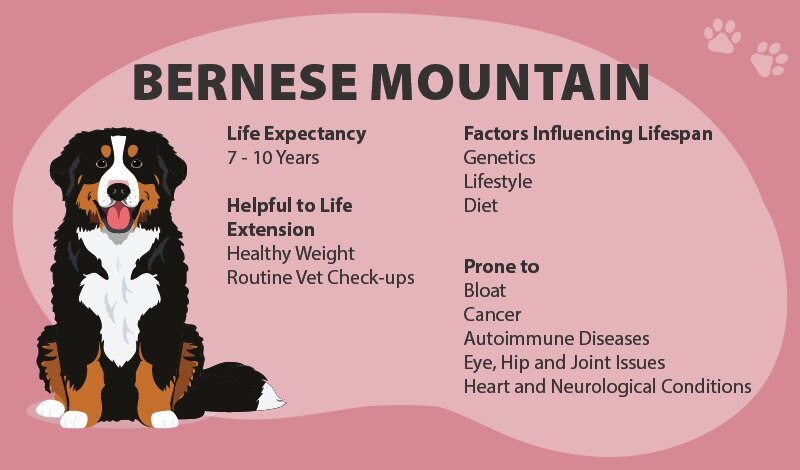
No dog’s lifespan feels long enough, but the Bernese mountain dog’s average life expectancy is only 7 to 10 years.1 Various factors, including genetics, diet and overall lifestyle, determine an individual dog’s lifespan. Keeping your Berner at a healthy weight and maintaining routine vet checkups can help extend their life.
High-quality dog food that’s appropriate to your dog’s life stage and meets the nutritional standards set by the Association of American Feed Control Officials (AAFCO) will provide your Berner with good nutrition.1 If you're considering a homemade diet, consult your vet to ensure all nutritional needs are met.1 Large breed dog and puppy food, formulated to support large and rapidly growing bones, is best for Berners.7 If you have any concerns about the best food or proper feeding amounts, your vet can provide guidance.
The Bernese mountain dog is generally considered a healthy breed. But while ethical breeders strive to strain out genetic health conditions and are working hard to extend the Berner’s life expectancy, as with all breeds Berners are prone to several health conditions, some of which are serious and costly.5 These include:
Allergies
Bernese mountain dogs are often prone to food allergies, which can result in inflammatory bowel disease and other digestive issues.8 They may also develop seasonal allergies that cause itchy, irritated skin, a condition known as atopic dermatitis.9 Diagnosing and treating food allergies can be difficult, sometimes requiring an elimination diet to identify the source.10 However, there are several options available for treating seasonal allergies, including Cytopoint®, a new injectable therapy that offers relief for itchy dogs.11 Working closely with your vet is essential to ensure your Berner pup feels its best.
Autoimmune diseases
Berners are prone to developing autoimmune conditions, where the immune system mistakenly attacks the body’s own cells. One such disorder in Berners is aseptic meningitis, a potentially serious condition affecting puppies between 3 and 12 months of age.8 It causes inflammation in the nervous system, which — without prompt treatment — can lead to chronic neurological issues.12 Fortunately, most Bernese pups who receive treatment with corticosteroids recover well and go on to live healthy lives.12
Bloat
Gastric dilatation and volvulus (GDV), more commonly known as bloat, is a serious and potentially fatal condition in which the stomach bloats with gas and twists on itself, cutting off circulation. Common signs include dry heaving and an extended abdomen, which should be treated like a life-threatening emergency. This is an acute condition for which most large breeds have a higher susceptibility. Talk to your vet about ways to reduce your dog’s chances of getting this condition.8
Cancer
Berners are genetically prone to two types of cancer: histiocytic sarcoma and mast cell cancer.8
- Histiocytic sarcoma. This is an aggressive cancer affecting primarily middle-aged and senior dogs. It can occur in multiple locations within the body, which can affect both signs and symptoms as well as treatment approaches. Treatment usually involves chemotherapy and, if the location allows it, surgery.13
- Mast cell cancer. This type of cancer results from a tumor composed of mast cells, which are white blood cells that release histamines into the bloodstream when exposed to allergens. These tumors can appear as lumps or bumps beneath the skin’s surface, as well as on the liver, spleen, bone marrow and intestines. Surgical removal is the primary treatment, though chemotherapy may be required in some cases.14
Degenerative myelopathy
This is an inherited neurological condition that can cause paralysis in the hindquarters, usually affecting older dogs. It’s an incurable condition, but various treatments, including acupuncture, dietary supplements and physical therapy, might help.9
Eye problems
Some eye health issues also impact Bernese mountain dogs. These include:
- Cataracts. A cataract is a cloudy film that develops over the lens of the eye, impairing vision and eventually causing blindness. Often, cataracts can be removed with a simple surgical procedure.9
- Ectropion and entropion. These conditions affect the eyelids, with ectropion causing them to roll outward and entropion causing them to fold inward.8 Both conditions lead to severe eye irritation and can result in permanent corneal damage.8 However, they can be corrected with surgery.9
- Progressive retinal atrophy. This incurable degenerative eye disease eventually leads to blindness. The inherited form that affects Berners typically develops in puppyhood, around 2 to 3 months of age. It’s a painless condition, and puppies usually adapt well to life without sight, learning to rely on their other senses to navigate the world.15
Hip and joint problems
Berners are susceptible to hip and joint issues that affect most large breeds. These include:8
- Hip and elbow dysplasia. This inherited condition affects many large breeds, causing joints to become dislocated due to the ball not fitting properly into the socket. It can impact both the hip and elbow joints, often leading to joint stiffness and arthritis as dogs age. Severe cases may require surgical correction.9
- Osteochondritis dissecans (OCD). This condition primarily affects male pups between 6 and 9 months old. It occurs when inflammation causes the cartilage to separate from the bone, most commonly in the shoulder, though it can also affect the elbow, hip and knee joints. It may be treated with a combination of rest, dietary changes, supplementation and medications, but severe cases may require surgery.16
Subaortic stenosis (SAS)
This congenital heart defect involves a band of abnormal tissue that forms below the aortic valve, forcing the heart to work harder to pump blood throughout the body. This extra strain causes the heart muscle to thicken, potentially leading to a heart murmur. While often asymptomatic, if left untreated, it can result in sudden death. When detected, the condition is managed with medication and lifestyle changes.17
Buying or Adopting a Bernese Mountain Dog
Bernese mountain dog puppies from reputable breeders generally range in price from $3,000 to $5,000, depending largely on location and whether the parents belong to championship lines.5 The price typically includes early healthcare, vaccinations and genetic testing.
Bernese mountain dogs and Berner mixes of all ages may be available to adopt from pet shelters and rescue organizations. Adoption fees will vary based on where you adopt, but the National Bernese Mountain Dog Rescue Network charges $600 to $1,200 depending on age, with puppies costing the most and senior dogs costing the least. Fees cover the costs of transport as well as health and wellness care.18
Frequently Asked Questions About Bernese Mountain Dogs
Here’s some additional info about Bernese mountain dogs, based on questions people are asking:
CareCredit Credit Card Financing for Dogs
Taking good care of your pet's well-being from nose to tail is essential. Make sure to stay up to date on their regular checkups at the vet to help keep your pet happy and healthy for a lifetime of love. You can use your CareCredit credit card for pet care throughout the year for routine veterinary services as well as emergencies and surgeries.* Use our Acceptance Locator to find a veterinarian near you that accepts CareCredit.
CareCredit is there for you and your pet every step of the way; continue your wellness journey by downloading the CareCredit Mobile App to manage your account, find a provider on the go and easily access the Well U blog for more great articles, podcasts and videos.
In addition to pet care, you can also use your CareCredit credit card for dentistry, cosmetic, vision, hearing, health systems, dermatology, pharmacy purchases, spa treatments and so much more within the CareCredit network. How will you invest in your health and wellness next?
Author Bio
Jean Marie Bauhaus is a freelance writer and novelist who has been writing pet content since 2013. Her work has appeared on Forbes.com, Hill's Pet, Chewy, AKC.org and more.



